California’s diverse ecosystems serve as a beautiful backdrop for bird enthusiasts. This free photo guide spotlights ten of the Golden State’s most striking orange birds, from the sun-kissed hues of the Baltimore Oriole to the fiery brilliance of the Rufous Hummingbird.
Pack your binoculars and get ready to discover these vivid avian wonders against California’s breathtaking landscapes.
Orange Birds Found In California
With its extensive coastline, towering mountain ranges, vast deserts, and lush forests, California’s wide array of ecosystems harbors a rich diversity of bird species, each finding its own niche in this abundant mosaic of habitats.
Baltimore Oriole


| Feature | Measurement |
|---|---|
| Scientific Name | Icterus galbula |
| Length | 6.7–8.7 in |
| Wingspan | 9.1–12.6 in |
| Weight | 22.3-42 g |
The Baltimore Oriole is a stunning bird, best known for its vibrant coloration and its rich, whistling song.
Appearance: The male Baltimore Oriole is notable for his bright orange and black plumage and black and white wing bars, a stark contrast to the more muted yellow-brown coloration of the female. Both sexes, however, have long pointed bills and white bars on their wings.
Diet: Baltimore Orioles have a diverse diet that includes insects, fruits, and nectar. Their preference for sweet juices and fruit pulp often brings them to backyard feeders offering oranges and jelly.
Reproduction: The female Baltimore Oriole is responsible for building the distinctive hanging nest, often woven together from fine materials like hair and grass. These nests are usually high in trees to avoid predators. The female lays 3-7 eggs, which are incubated for about two weeks.
Bullock’s Oriole

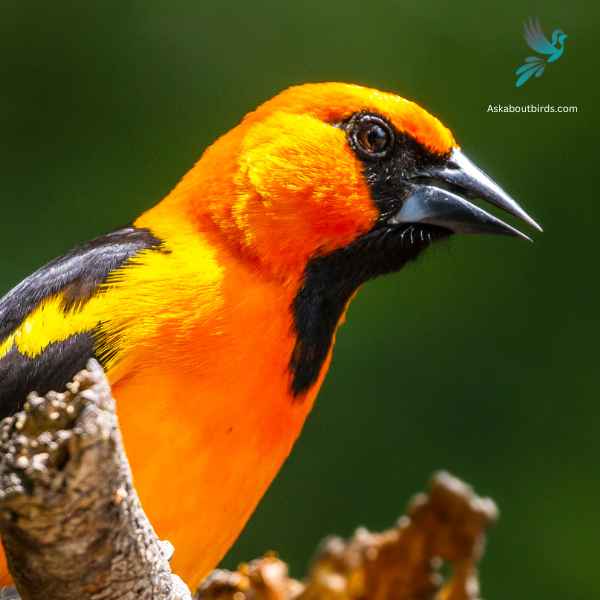
| Feature | Measurement (Imperial) |
|---|---|
| Scientific Name | Icterus bullockii |
| Length | 7.5-8.5 inches |
| Wingspan | 11.8-12.6 inches |
| Weight | 0.9-1.2 oz |
The Bullock’s Oriole is a bright and lively songbird, known for its stunning contrasting colors and vibrant melodies, predominantly found across the western regions of North America.
Appearance: The male Bullock’s Oriole boasts a brilliant orange chest, belly, and face with a black crown, eye line, throat, and back. Its wings are black with a prominent white patch and white-edged coverts. Females are more muted in coloration, displaying a yellowish-orange hue with grayish-brown wings that still retain the white patches.
Diet: These orioles primarily feed on insects, especially caterpillars, beetles, and grasshoppers. Apart from insects, their diet also includes fruits, berries, and nectar. They’re adept foragers, often hanging upside-down on branches to find hidden prey.
Reproduction: Bullock’s Orioles are noted for their skill in crafting hanging, woven nests, often positioned on the tips of slender branches, ensuring they are difficult for predators to access. Both parents partake in feeding the young, who then fledge about two weeks after hatching.
Hooded Oriole
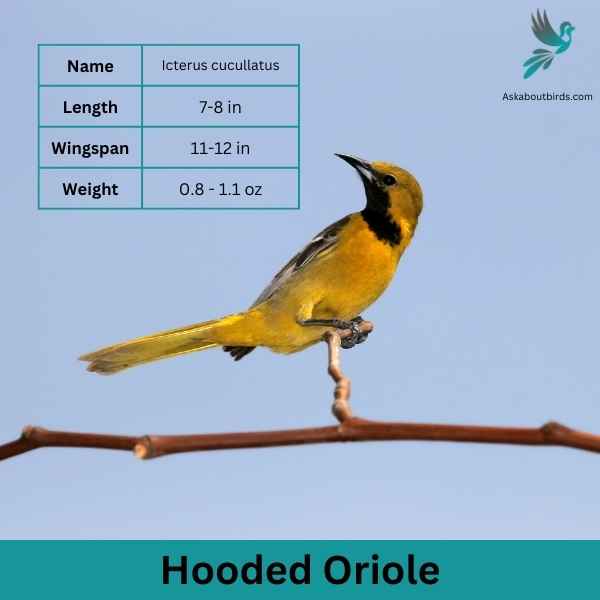

| Feature | Measurement |
|---|---|
| Scientific Name | Icterus cucullatus |
| Length | 7-8 in |
| Wingspan | 11-12 in |
| Weight | 0.8 – 1.1 oz |
The Hooded Oriole is a brightly colored bird commonly found in the southwestern United States and Mexico, recognized for its vibrant orange-yellow plumage and melodic songs.
Appearance: Males boast a deep orange body contrasted with a black bib, face, and throat, while the wings and tail are predominantly black with white wing bars. Females have a paler, yellow-green appearance, lacking the distinctive hood found in males. Both sexes have long tail feathers and a slightly curved bill.
Diet: The Hooded Oriole’s diet mainly consists of insects, nectar, and fruit. They are especially fond of the nectar from flowers and hummingbird feeders, often competing with hummingbirds for access.
Reproduction: These birds are known to use palm trees for nesting, weaving their nests to the underside of large palm fronds. The nest is a deep pouch, which offers protection to the 3-5 eggs that are typically laid. Both parents share in feeding the young after they hatch.
Western Tanager

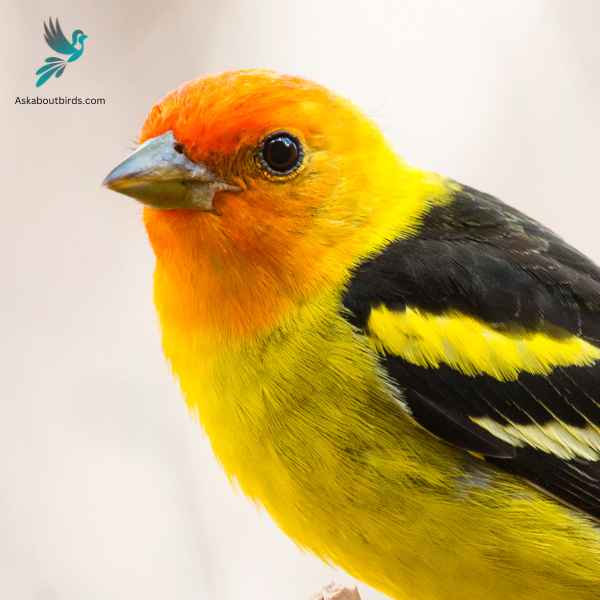
| Feature | Measurement |
|---|---|
| Scientific Name | Piranga ludoviciana |
| Length | 6.3-7.5 in |
| Wingspan | 11.5 in |
| Weight | 24-36 g |
The Western Tanager is a vibrant songbird that graces the forests and woodlands of the western regions of North America, enchanting observers with its colorful plumage and melodious song.
Appearance: The male Western Tanager is renowned for its bright yellow body contrasted with a striking red head and black wings and tail. The females are more subdued in hue, primarily being yellow with grayish wings and back, and lacking the brilliant red head of the males.
Diet: Western Tanagers primarily feed on insects, especially when breeding, but they also incorporate a significant amount of fruits and berries into their diet, especially during migration and winter.
Reproduction: Western Tanagers build their nests high in coniferous trees, often well concealed from potential predators. The female usually lays a clutch of 3 to 5 eggs and takes the primary role in incubation, while both parents are involved in feeding the chicks after they hatch.
American Redstart


| Feature | Measurement |
|---|---|
| Scientific Name | Setophaga ruticilla |
| Length | 4.3 to 5.5 in |
| Wingspan | 6.3 to 9.1 in |
| Weight | 8.6 g |
The American Redstart is a lively warbler known for its vivid colors and active hunting style, often seen flitting about, fanning its tail to startle and catch insects.
Appearance: Adult male American Redstarts boast striking black plumage with bright orange patches on the sides, wings, and tail. Females and immature males have grayish-olive upperparts with yellow patches in the same areas where the males display orange.
Diet: American Redstarts are primarily insectivores. They actively forage for flying insects, as well as caterpillars and spiders, often using their colorful tails to startle prey and make them easier to catch.
Reproduction: The female American Redstart builds a cup-shaped nest in the fork of a tree branch. Typically, she lays a clutch of 3 to 5 eggs. The female takes on the primary responsibility of incubating the eggs, while both parents participate in feeding the fledglings after they hatch.
Varied Thrush
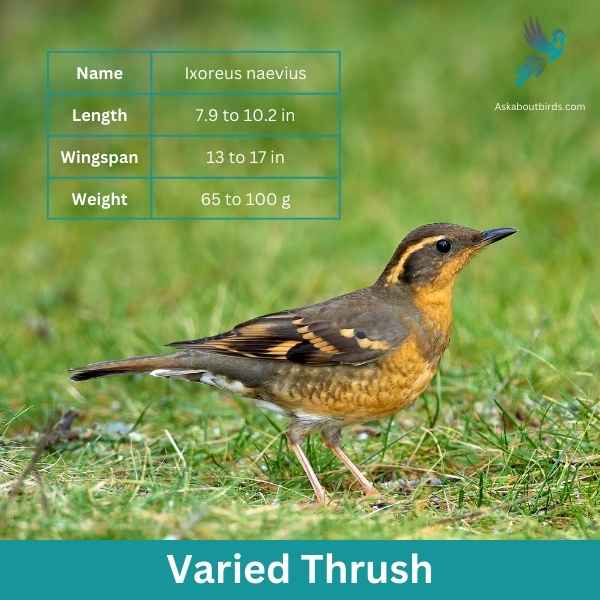

| Feature | Measurement |
|---|---|
| Scientific Name | Ixoreus naevius |
| Length | 7.9 to 10.2 in |
| Wingspan | 13 to 17 in |
| Weight | 65 to 100 g |
The Varied Thrush is a songbird known for its striking appearance and melodious, haunting song that echoes through the dense forests of the Pacific Northwest.
Appearance: The Varied Thrush has a bold pattern. Males display a blue-gray upper body, contrasted with an orange throat and breast, and a black band that extends from the eyes to the neck. The wings have two orange bands and the belly is usually lighter. Females have a similar pattern but are generally more muted in color.
Diet: Varied Thrushes primarily consume insects, berries, and seeds. Their diet can shift seasonally, with insects being more prevalent in the warmer months and berries and seeds making up the bulk of their diet in colder months.
Reproduction: Varied Thrushes nest in trees, often close to the trunk and concealed by dense branches or foliage. The female typically lays a clutch of 3 to 5 eggs, which she incubates.
Northern Cardinal


| Feature | Measurement |
|---|---|
| Scientific Name | Cardinalis cardinalis |
| Length | 8.3 – 9.1 in |
| Wingspan | 9.8 – 12.2 in |
| Weight | 1.19 – 2.29 oz |
The Northern Cardinal is an iconic North American bird, easily recognized by its vibrant color and melodious song.
Appearance: Male Northern Cardinals are a brilliant scarlet red, while females display a more subdued reddish olive. Both sexes have a distinctive black ‘mask’ on their face around the bill and a pointed crest on their head. The bird’s beak is robust, cone-shaped, and bright orange in color.
Diet: Northern Cardinals are primarily granivorous, with a diet largely consisting of seeds and grains. They also eat fruits and insects. These birds typically feed off the ground and are frequent visitors to bird feeders.
Reproduction: Northern Cardinals are monogamous, and a pair will breed together for life. The female typically builds a well-hidden nest in a dense thicket or shrub. She lays 2-5 eggs per clutch, which she incubates for around two weeks.
House Finch


| Feature | Measurement |
|---|---|
| Scientific Name | Haemorhous mexicanus |
| Length | 5–6 in |
| Wingspan | 8–10 in |
| Weight | 0.6–0.9 oz |
The House Finch is a small songbird widely distributed across North America and is commonly found in urban and suburban areas.
Appearance: Males of this species are brightly colored with crimson faces and throats, which can extend to the chest and back, while their flanks have streaks. The female is streaked brown and lacks the red coloring. Both have a square-tipped tail and a distinctively long, flat-topped bill.
Diet: House Finches primarily eat seeds, grains, and berries. They have a particular fondness for sunflower seeds and can be commonly seen at bird feeders. Occasionally, they will also consume insects, especially during the breeding season.
Reproduction: House Finches are cavity-nesters and might choose ledges, vents, ledges, and other urban settings. They might also utilize trees or shrubs. Their nests can be made of a wide array of materials, from feathers to twigs.
Allen’s Hummingbird

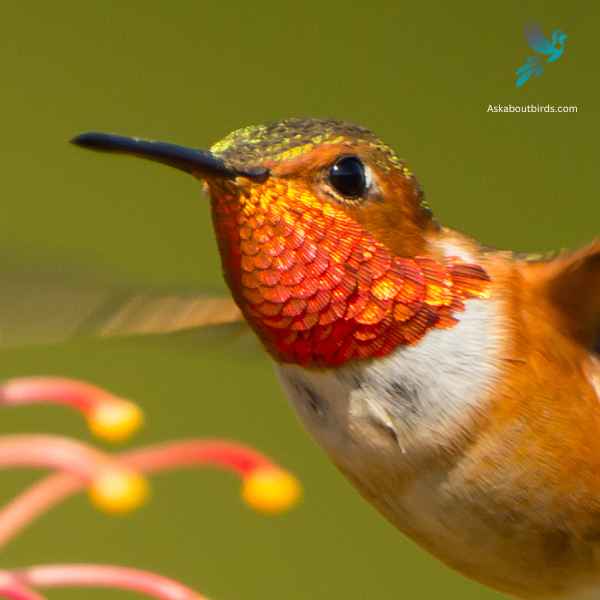
| Feature | Measurement |
|---|---|
| Scientific Name | Selasphorus sasin |
| Length | 3.5 in (9 cm) |
| Wingspan | 4.3 in (11 cm) |
| Weight | 0.1 oz (3 g) |
Allen’s Hummingbird is a small, energetic bird known for its vibrant plumage and rapid flight, commonly seen in the coastal areas of California.
Appearance: Male Allen’s Hummingbirds are noted for their iridescent orange-red throat, or gorget, and bronze-green upperparts. Their tail feathers are typically rufous with black tips. Females, on the other hand, display more subdued coloration with greenish upperparts and whitish underparts, with speckles on the throat.
Diet: Like most hummingbirds, Allen’s Hummingbird feeds primarily on nectar from a variety of flowering plants, with a preference for red or orange flowers. They supplement their diet with small insects and spiders, which provide necessary proteins.
Reproduction: The breeding season for Allen’s Hummingbirds typically starts in January. They build their nests out of plant fibers and spider webs, usually in trees or shrubs. The female is solely responsible for nest building, incubation, and caring for the young.
Rufous Hummingbird


| Feature | Measurement |
|---|---|
| Scientific Name | Selasphorus rufus |
| Length | 3.1–3.9 in |
| Wingspan | 4.3 in |
| Weight | 0.1–0.2 oz |
The Rufous Hummingbird is a small, brilliantly colored bird known for its impressive migratory journeys and feisty behavior.
Appearance: The male Rufous Hummingbird boasts a gleaming orange-red body with a white chest and an iridescent red throat, called a gorget. The female has green upperparts with rufous-washed flanks and tail. Her throat may have some iridescent patches, but it’s generally whitish.
Diet: Like other hummingbirds, the Rufous Hummingbird primarily feeds on nectar from a variety of flowering plants. They also eat insects and spiders for protein, catching them in flight or plucking them from vegetation.
Reproduction: Rufous Hummingbirds nest in trees, shrubs, or even ferns. The female alone selects the site, builds the nest, and cares for the offspring.
Where to Spot California’s Orange Birds
California, with its diverse geography ranging from the Pacific coastline to the Sierra Nevada mountains, the Mojave Desert to lush forests, serves as an ideal habitat for a wide variety of birds, including numerous strikingly orange species. Here are some of the top locations in the Golden State for bird watching, particularly for those seeking to observe these colorful creatures:
- Point Reyes National Seashore, Marin County: An impressive birding site due to its varied habitats, Point Reyes is a magnet for migratory birds, including some orange species. Here, you can enjoy bird watching in marshlands, coastal cliffs, and forests all in one place.
- Monterey Bay, Monterey County: A global hotspot for birding, Monterey Bay offers an opportunity to observe seabirds and shorebirds along the coastline, including some vibrant orange species during migration season.
- Salton Sea, Riverside/Imperial County: The Salton Sea, a massive inland lake, draws a wide variety of bird species, making it an excellent location for bird watching. The area around the Sea is a critical stopover point for migratory birds, including many orange avian species.
- Yosemite National Park: Known for its majestic waterfalls and stunning vistas, Yosemite also hosts a vast array of bird species. The park’s diverse habitats make it a haven for birdwatchers looking to spot unique orange birds.
- Farallon Islands, San Francisco: Located off the coast of San Francisco, the Farallon Islands serve as nesting grounds for a variety of bird species. Despite the remoteness, bird watching trips to the islands provide opportunities to spot a number of unique and colorful birds.
| State’s Orange Birds | Best Spots to See Orange Birds |
|---|---|
| Oregon’s Orange Birds | Malheur National Wildlife Refuge, Portland’s Forest Park, Klamath Basin |
| Nevada’s Orange Birds | Red Rock Canyon National Conservation Area, Humboldt-Toiyabe National Forest, Great Basin National Park |
| Arizona’s Orange Birds | Saguaro National Park, Madera Canyon, Gilbert Riparian Preserve |
FAQs on Orange Bird Species Found in California
What are the bright orange birds in California?
In California, the birds known for their bright orange plumage include the Black-headed Grosbeak. These birds, commonly found across western North America, are particularly noticeable due to their contrasting black and white wings paired with their bright orange patches, making them a delightful sight for bird enthusiasts.
What kind of bird is orange in color?
The Black-headed Grosbeak stands out as a prominent bird with orange plumage in western North America. Adorned with a mix of bright orange head and patches combined with distinct black and white wings, this species offers a captivating splash of color against the natural landscape.
What are the orange belly birds in Northern California?
In Northern California, among the orange-breasted birds, the Black-headed Grosbeaks are prominent. With their unmistakable bright orange patches, especially on their belly, combined with their unique song, they are a summer treat for birdwatchers in the region.
What is the orange and yellow bird in Northern California?
One bird that showcases a blend of orange and yellow-orange in Northern California is the Red-breasted Nuthatch. Though it’s more renowned for its rusty orange undertones, when combined with certain lighting, the hues can shift, appearing as a blend of yellow-orange, especially against the backdrop of California’s diverse habitats.




